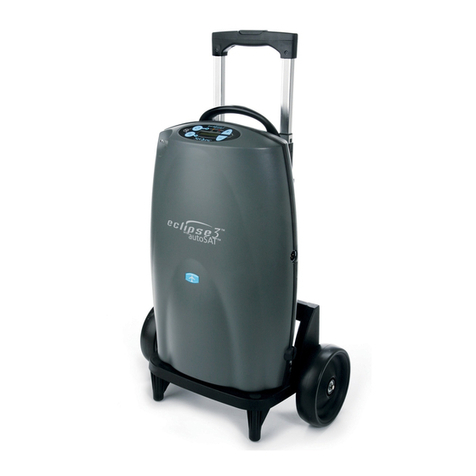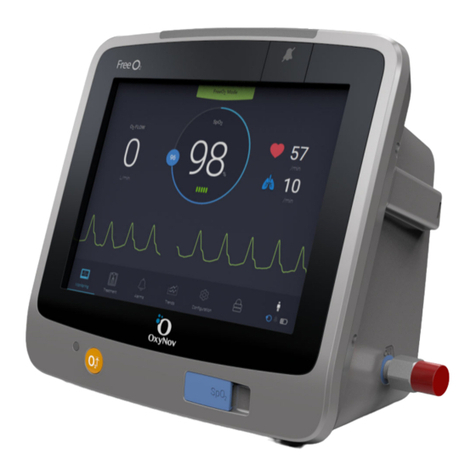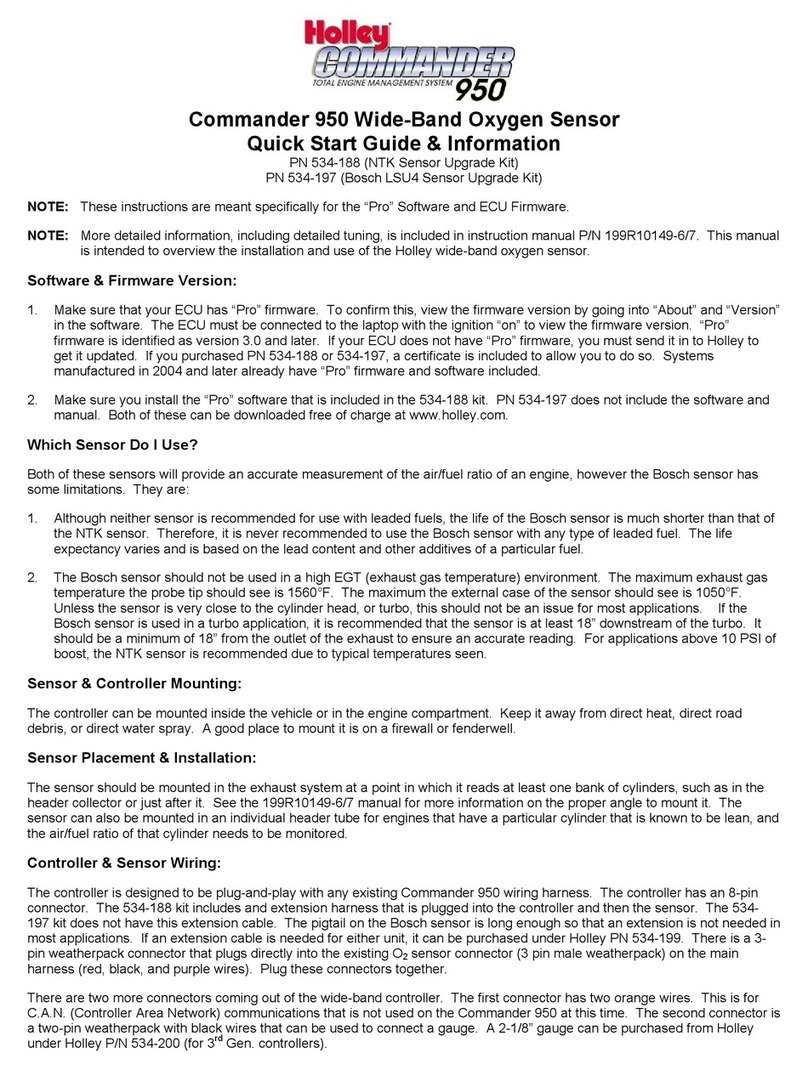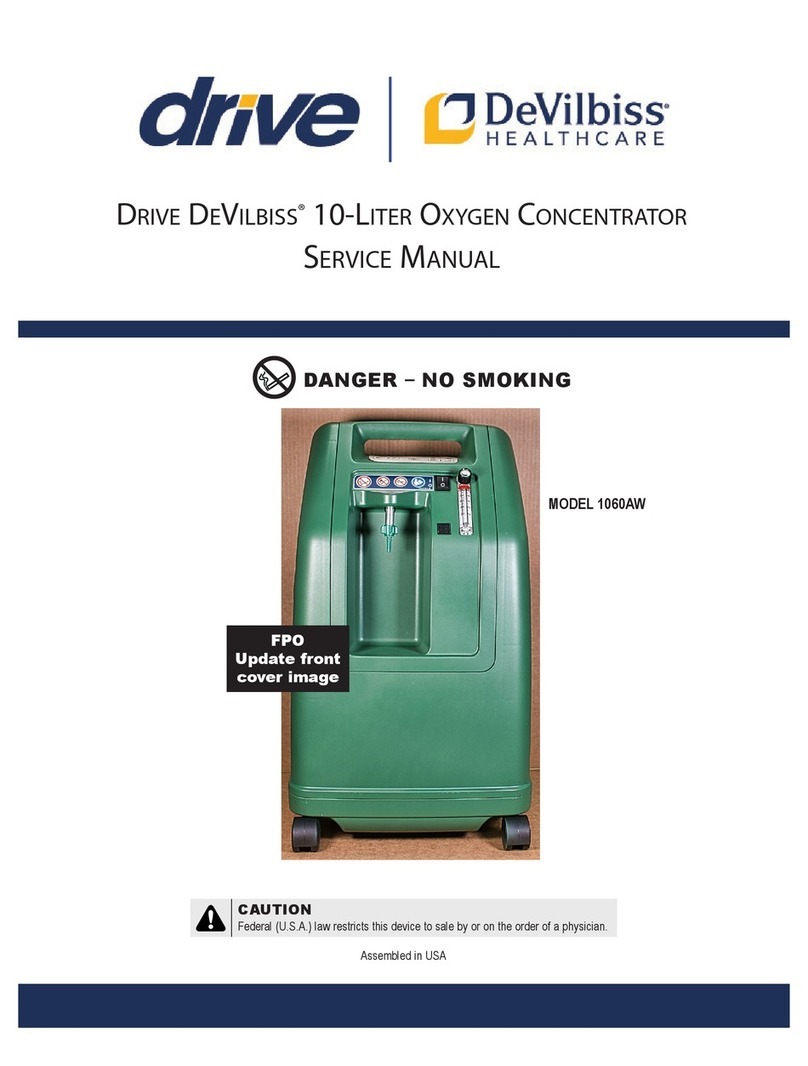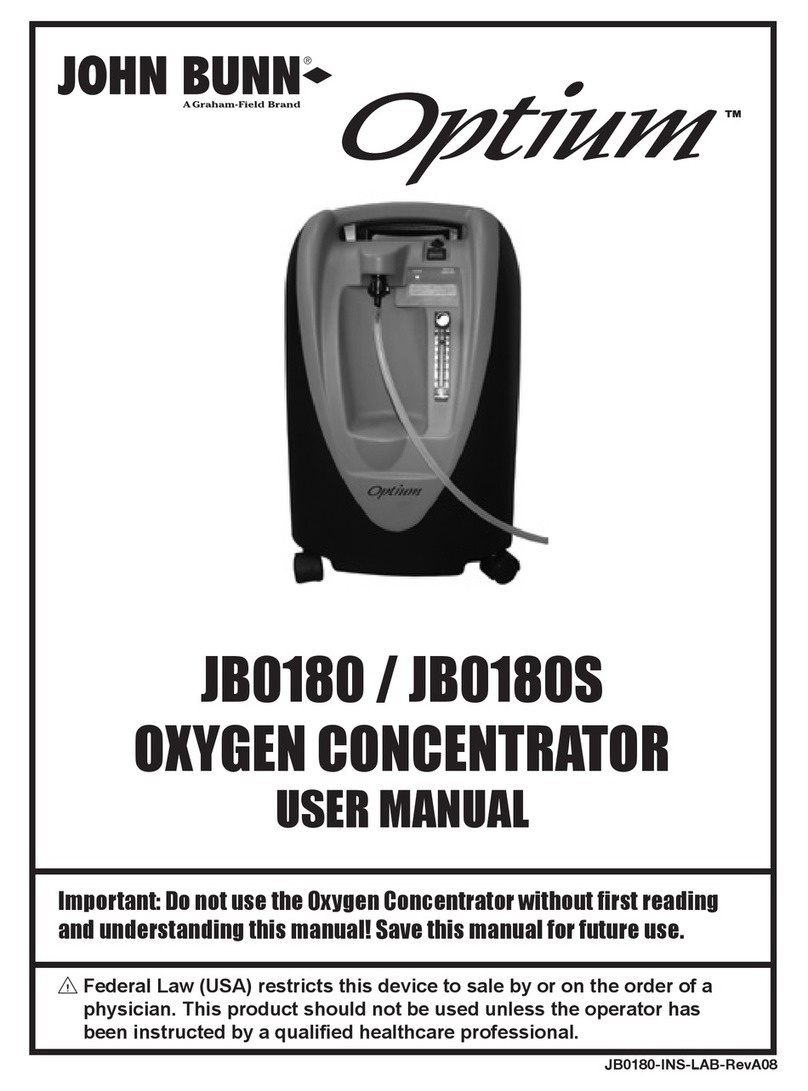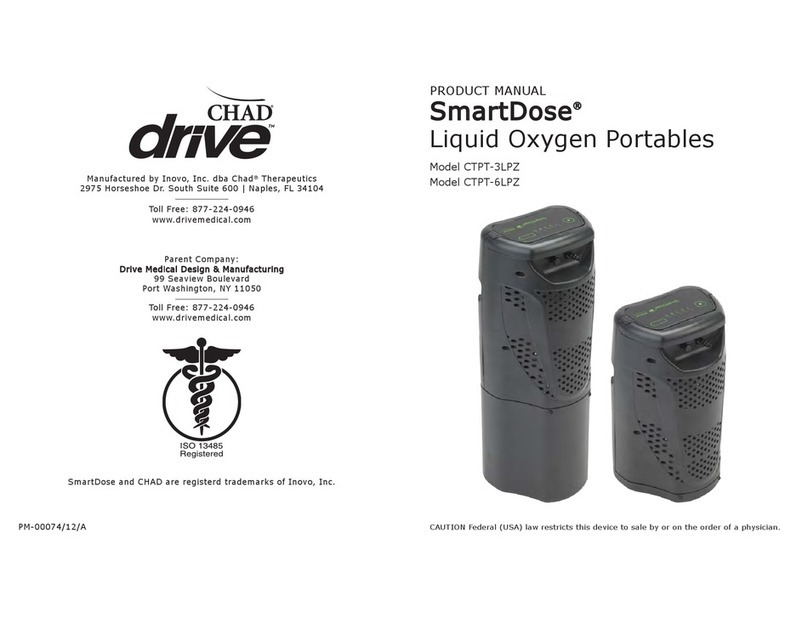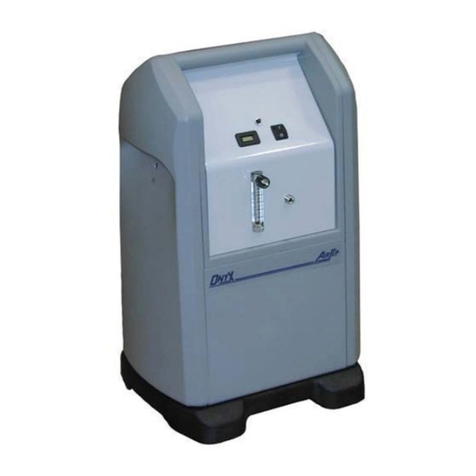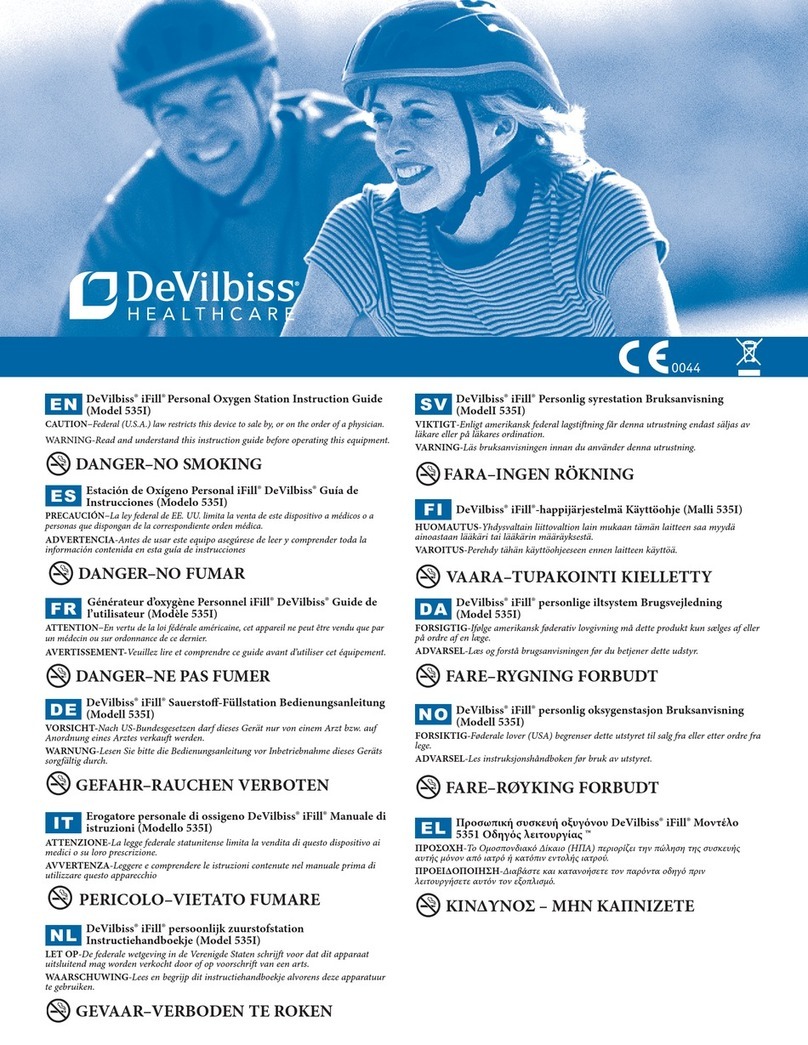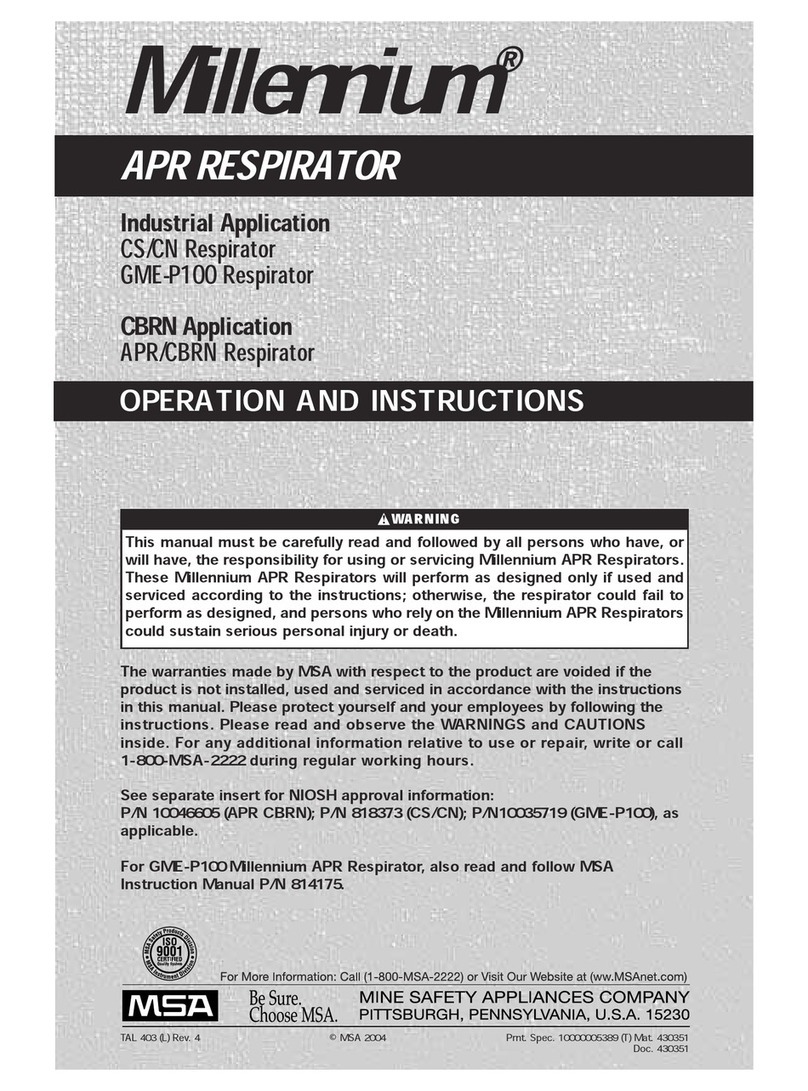EO2 Concepts OxyGeni User manual

® OXYGEN GENERATOR and
OxySpur® ABSORBENT FOAM DRESSING,
ADHESIVE and NON-ADHESIVE, for
ONTINUOUS DIFFUSION of OXYGEN
THERAPY
INSTRU TIONS FOR USE
For Single use
p
Keep Dry Store at Room Temperature Gamma Sterilized
PRODU T DES RIPTION
The OxyGeni System consists of the OxyGeni Oxygen Generator, Oxygen
Delivery Extension Sets, USB Charger, OxyGeni Power Pack, Carrying Case an
the OxySpur Oxygen Diffusion Dressings. Optional Humi icant Packs are
available for use in low humi ity environments.
The OxyGeni Oxygen Generator uses fuel-cell technology to continuously produce oxygen. t
is rechargeable and should be recharged daily. The pure, humidified oxygen flows out of the
O2 port through the Oxygen Delivery Extension Set to the OxySpur Oxygen Diffusion Dressing.
The OxySpur Oxygen Diffusion Dressing is a hydrophilic dressing designed for use with the
OxyGeni tissue oxygenation device in the management of wounds. The dressing is available
in two forms: OxySpur for wounds with medium to high levels of exudate, and OxySpur L TE
for wounds with low to minimal exudate.
The OxySpur dressing is a multi-layer construct with a highly absorbent hydrophilic foam layer
directly adjacent to the wounds, a highly absorbent hydrophilic foam layer with channels for
oxygen distribution, and a super absorbent polymeric laminate, all of which are covered by
an occlusive film. The adhesive version also includes a hydrocolloid adhesive border. All
versions contain an integrated oxygen delivery cannula that supplies oxygen into the oxygen
distribution foam layer. The super absorbent layer converts wound fluids into a gel,
absorbing and retaining fluid from the foam wound contact layer, thereby maintaining an
optimally balanced moisture level in the wound contacting layer for an extended period.
OxySpur L TE differs in that it has a non-adherent mesh layer directly adjacent to the wound,
one hydrophilic, yet less absorbent foam layer which is covered by an occlusive film, and an
adhesive border. OxySpur L TE is to be used on wounds with minimal to low exudate, such
as later in the healing cycle when wound exudate levels decrease.
One goal of oxygen therapy is to provide an uninterrupted and continuous supply of oxygen to
a moist wound. The dressing is designed such that the oxygen is supplied in a manner that
most closely approximates the normal diffusion of oxygen in moist tissues, yet at a rate
sufficient to fuel the increased oxygen demands required in healing tissues. This therapy is
known as Continuous Diffusion of Oxygen (CDO) therapy. The dressing helps to provide an
environment for optimal wound healing by providing CDO therapy while managing wound
exudate levels, protecting against wound dehydration and protecting against external
contamination.
OxySpur is available with or without an adhesive border. OxySpur L TE is only available with
an adhesive border. Both versions are referred to simply as OxySpur herein.
INDI ATIONS
CDO therapy is designed for patients who would benefit from wound oxygenation as it may
promote wound healing via increased collagen production, angiogenesis, reactive oxygen
species generation, and increased cell metabolism. The OxyGeni System is indicated to treat
wound types including:
• Skin ulcerations resulting from:
• diabetes
• venous stasis
• postsurgical infections
• gangrenous lesions
• Pressure ulcers
•
nfected residual limbs
•
Skin grafts
•
Burns
•
Frostbite
Since the dressings are able to absorb and retain fluid under pressure they
use under compression. The dressings may be used to
protection throughout the healing process.
While
OxySpur
effective wear time
ONTRAINDI ATIONS
The
OxyGeni
•
Wounds with inadequate perfusion to support healing
•
Ulcers due to acute thrombophlebitis
•
Ulcers due to Raynaud’s dise
•
Necrotic wounds covered with eschar or slough
•
Wounds with fistulae or deep sinus tracts with unknown depth
PRE AUTIONS AND OBSERVATIONS
CAUT ON: Sterility of the dress
prior to use. DO NOT use if
• A
significant increase in exudate
resulting in the need for more frequent assessment and
frequency of dres
dressing
•
The sterile dressings are intended for single use only
•
Do not use after expir
•
n case of intolerance to the dressing, remove and clean the area carefully
•
During the body’s natural healing process,
may be
wound appear larger
•
f the wound continues to grow larger after the first few dressing changes, consult a
healthcare professional
•
t is
(such as petrolatum, salves or ointments), are not applied over the wound bed below the
OxySpur dressing as this will impair performance of CDO
•
The
must be taken to apply the dressing such that the occlusive film is facing away from the
wound not contacting the wound surface as this will impair CDO performance
•
Appropriate
compression in the management of venous leg ulcers or pressure
measures in the management of pressure ulcers, systemic antibiotics and frequent
monitoring in the treatment of wound infection, control of blood glucos
for diabetic ulcers, etc.)
•
The wound should be assessed during dressing changes
•
When
dressing and the end of the tubing attached to the dressing are protected so
does not enter the top of the tube or the dressing
•
Do
•
Do not cut tubing or pull on the tubing
•
Do not connect a
•
The
system
•
Always
tubing should be positioned uppermost (going toward the head) on intact skin and not
extend over the wound so that the risk o
potentially blocking the flow of oxygen is minimized
•
CT scans
w
here possible, move the OxyGeni ou
been taken into the CT scan or x
the procedure
•
This
patient may result in cross
•
High
•
Consult
increased redness, wound drainage); excessive bleeding; an unexpected change in
wou
(allergic reaction); no signs of healing
•
These
professional
• f
have additional questions a
supplier
•
f you
or clinical caregiver
•
Please report any
EO
2
•
Federal law
DIRE TIONS FOR USE
Latex
-
Free
K
D
l
K
30
ºC
86ºF
10ºC
50ºF
nfected residual limbs
Skin grafts
Burns
Frostbite
Since the dressings are able to absorb and retain fluid under pressure they
are suitable for
use under compression. The dressings may be used to
provide moisture management and
protection throughout the healing process.
OxySpur
can be used on highly exuding wounds, the level of exudate will determine the
effective wear time
of the dressing, and the wound should be monitored accordingly.
ONTRAINDI ATIONS
OxyGeni
System is contraindicated for the following:
Wounds with inadequate perfusion to support healing
Ulcers due to acute thrombophlebitis
Ulcers due to Raynaud’s dise
ase
Necrotic wounds covered with eschar or slough
Wounds with fistulae or deep sinus tracts with unknown depth
PRE AUTIONS AND OBSERVATIONS
CAUT ON: Sterility of the dress
ing is guaranteed unless the pouch is damaged or opened
prior to use. DO NOT use if
either has occurred.
significant increase in exudate
may occur during the early phase of CDO therapy,
resulting in the need for more frequent assessment and
dressing changes. To reduce the
frequency of dres
sing changes, you may add absorptive dressings under the OxySpur
dressing
The sterile dressings are intended for single use only
Do not use after expir
ation date
n case of intolerance to the dressing, remove and clean the area carefully
During the body’s natural healing process,
edema may decrease and non-viable tissue
may be
removed from the wound (autolytic debridement), which could initially make the
wound appear larger
f the wound continues to grow larger after the first few dressing changes, consult a
healthcare professional
t is
important that occlusive materials, such as film dressings or oil-based products
(such as petrolatum, salves or ointments), are not applied over the wound bed below the
OxySpur dressing as this will impair performance of CDO
The
OxySpur dressing has an occlusive film on one side (the side with bubbles) and care
must be taken to apply the dressing such that the occlusive film is facing away from the
wound not contacting the wound surface as this will impair CDO performance
Appropriate
supportive measures should be taken where necessary (e.g. use of
compression in the management of venous leg ulcers or pressure
redistribution
measures in the management of pressure ulcers, systemic antibiotics and frequent
monitoring in the treatment of wound infection, control of blood glucos
e and offloading
for diabetic ulcers, etc.)
The wound should be assessed during dressing changes
When
showering the OxyGeni should be disconnected from the dressing: ensure the
dressing and the end of the tubing attached to the dressing are protected so
that water
does not enter the top of the tube or the dressing
Do
not take the OxyGeni apart
Do not cut tubing or pull on the tubing
Do not connect a
Y splitter to the tubing since this may impair CDO performance
The
OxyGeni can be charged using any other USB charger than that supplied with the
system
Always
ensure that the dressing is positioned centrally over the wound: the dressing
tubing should be positioned uppermost (going toward the head) on intact skin and not
extend over the wound so that the risk o
f fluid collecting around the tubing and
potentially blocking the flow of oxygen is minimized
CT scans
and x-ray have the potential to interfere with some electronic medical devices:
here possible, move the OxyGeni ou
t of the x-ray or scanner range: if the OxyGeni has
been taken into the CT scan or x
-ray range, check that it is functioning correctly following
the procedure
This
OxyGeni is single patient use only: use of any part of this system on more than one
patient may result in cross
-contamination that may lead to infection
High
temperatures and humidity may reduce wear times of dressings
Consult
a healthcare professional if there are: signs of infection (increased pain,
increased redness, wound drainage); excessive bleeding; an unexpected change in
wou
nd color and/or odor; irritation (increased redness and/or inflammation); sensitivity
(allergic reaction); no signs of healing
These
instructions are not intended to supersede the instructions of your health care
professional
have additional questions a
bout your OxyGeni System please call your local wound care
supplier
f you
have immediate medically related questions or concerns, please call your physician
or clinical caregiver
Please report any
serious incident that has occurred in relation to the OxyGeni System to
2
Concepts and the authority having jurisdiction in your locale.
Federal law
(USA) restricts this device to sale or rental by or on the order of a physician
DIRE TIONS FOR USE
System set up
•
Be sure to have these items available to comp
o
OxyGeni
Oxygen Generator and Wound Monitoring Device
o
OxyGeni
Oxygen Delivery Extension Set (
o
OxySpur Dressing (size of dressing is determined by your
•
Optional items:
o
OxyGeni
Power Pack
o
OxyGeni
Carrying Case
o
OxyGeni
Humidicant Pack
o
Skin prep
o
Compression sock or wrap
o
Fixative film
o
Alginate or other
APPLYING THE OxySpur DRESSING
Prior to application:
•
C
leanse the wound
•
Debride wound of
devitalized tissue (eschar, slough, etc. may interfere with oxygen
delivery)
•
Select a dressing that will allow the wound contact area to completely
and extend onto healthy tissue
•
Use Skin protection before applying an adhesive dressing
NOTE: Do not
use oil b
allow oxygen to penetra
typically water based and work well with CDO.
Applying
Adhesive OxySpur Dre
NOTE:
Use of a skin pro
are concerned that the
non-
adhesive dressing instead.
•
Hydrocolloid
adhesives work mor
your hands prior to application. Remove part of the clear liner to expose the adhesive
(hydrocolloid) portion of the dressing
•
Orient the dressing
patient is standing o
when the patient removes the OxyGeni to shower or bathe
•
Position and smooth into place
clear plastic liner
•
Carefully smooth
aro
adhesive film border and the periwound skin
•
Briefly apply pressure
(hydrocolloids activate with heat an
NOTE: The adhesive
borders
the next dressing change.
changes, unless instructed to do so by a clinical caregiver.
needed when removing the dressing.
Applying Non-
Adhesive OxySpur Dressings:
NOTE:
Use of a skin protectant should be used before placing the dressing to protect the
peri-
wound from maceration.
•
Orientate the
dressing such that the tu
patient is standing o
when the patient removes the OxyGeni to shower or bathe
•
Place
the dressing over the wound.
(The side with the
b
•
A
secondary film dre
OxySpur dressing to secure the dressing in place
•
f required, the dressing can be cut,
product delamination
•
For
highly exuding wounds, be sure to secure any fixative over all of the edges of the
dressing
NOTE:
slight pressure sh
contacts the surface of
into the dressing and can be achieved using a wrap or a sock.
use with compression, from light compression stockings up to 4 layer compression wraps
NOTE: The seal around the dressing edges does not have to be perfect, yet gaps or tears
could allow exudate to damage the periwound and potentially lower o
the wound site. Too tigh
being produced than consumed by the wound, the oxygen pressure will build in a tightly
confined space).
•
Patients are advised
instructed to by clinical caregiver.
could allow
excessive exudate to damage the periwound
concentration at the wound site, which could affect the efficacy of the therapy
OxySpur ANNULA ORIENTATION & PLA EMENT
For
instructional videos, visit our
YouTube.com.
Be sure to have these items available to comp
lete your system set up:
Oxygen Generator and Wound Monitoring Device
Oxygen Delivery Extension Set (
connecting tubing)
OxySpur Dressing (size of dressing is determined by your
clinical caregiver)
Power Pack
Carrying Case
Humidicant Pack
Compression sock or wrap
Alginate or other
hydrophilic fill materials
APPLYING THE OxySpur DRESSING
leanse the wound
area.
devitalized tissue (eschar, slough, etc. may interfere with oxygen
Select a dressing that will allow the wound contact area to completely
cover the wound
and extend onto healthy tissue
Use Skin protection before applying an adhesive dressing
oil based products such as petrolatum, salves or ointments: they do not
enetrate and will impair the efficacy of CDO therapy. Gels and creams are
typically water based and work well with CDO.
Adhesive OxySpur Dre
ssings:
in protectant should be used before placing the adhesive dressing. f you
t the patient’s skin will not tolerate a strong adhesive, we advise using the
adhesive dressing instead.
adhesives work mor
e efficiently when warm. Warm the adhesive portion with
your hands prior to application. Remove part of the clear liner to expose the adhesive
(hydrocolloid) portion of the dressing
Orient the dressing
such that the tubing exiting the dressing is on top/up when the
ding or resting. This will help to prevent exudate from entering the tubing
when the patient removes the OxyGeni to shower or bathe
Position and smooth into place
(bubble-side up) while removing the second half of the
around the edge of the dressing to ensure good contact between the
adhesive film border and the periwound skin
Briefly apply pressure
to the adhesive until it becomes firmly attached to the skin
(hydrocolloids activate with heat an
d pressure)
borders
are designed to be strong enough to stay on the patient until
the next dressing change.
Advise patients against lifting or removing the dressing between
changes, unless instructed to do so by a clinical caregiver.
An adhesive remover may be
needed when removing the dressing.
Adhesive OxySpur Dressings:
Use of a skin protectant should be used before placing the dressing to protect the
wound from maceration.
dressing such that the tu
bing exiting the dressing is on top/up when the
ding or resting. This will help to prevent exudate from entering the tubing
when the patient removes the OxyGeni to shower or bathe
the dressing over the wound.
Ensure the foam side is face down against the wound
b
ubble print should be facing out)
lm dressing, tape, wrap or conforming bandage should be applied over the
OxySpur dressing to secure the dressing in place
f required, the dressing can be cut,
although note that this may increase the risk of
product delamination
highly exuding wounds, be sure to secure any fixative over all of the edges of the
ure should be placed on the entire dressing to ensure that the dressing
ce of the wound. This enables wicking of excess fluid from the wound bed
into the dressing and can be achieved using a wrap or a sock.
All dressings are suitable for
use with compression, from light compression stockings up to 4 layer compression wraps
.
NOTE: The seal around the dressing edges does not have to be perfect, yet gaps or tears
could allow exudate to damage the periwound and potentially lower o
xygen concentration at
o tight of a seal may cause a blockage alarm over time (if more oxygen is
being produced than consumed by the wound, the oxygen pressure will build in a tightly
vised against lifting or removing the dressing between changes, unless
instructed to by clinical caregiver.
Ensure that the edges are firmly sealed. Gaps or tears
excessive exudate to damage the periwound
and potentially lower the oxygen
concentration at the wound site, which could affect the efficacy of the therapy
OxySpur ANNULA ORIENTATION & PLA EMENT
instructional videos, visit our
YouTube channel: search "EO2 Concepts” on

Orient the OxySpur dressing such that the tubing is on top/facing up as it exits the dressing
when the patient is standing or resting. This will help to prevent exudate from entering the
tubing when the patient removes the OxyGeni to shower or bathe. The luer lock should be
accessible to connect/disconnect.
NOTE: Cannula should be secured with tape in order to reduce any pressure that may result
from the device.
ONNE TING OxySpur DRESSING TO THE OXYGENI
•
Connect the dressing to the Extension Set by inserting the male luer fitting of the
Extension Set into the female end of the OxySpur Dressing’s cannula and turn clockwise
until secure (about ¼ turn)
•
To ensure the cannula does not get pulled out of the dressing, it is recommended to
make a pigtail loop and secure it either on top of the dressing or adjacent to the dressing
•
Route the Extension Set inside clothing and attach it to intact skin with surgical tape.
Ensure to allow for the tubing to have freedom of movement
•
Connect the female luer end of the Extension Set to the male port labeled “O2” on the
top right side of the OxyGeni by inserting and turning clockwise (about ¼ turn)
NOTE: Ensure that all connections are secure so that oxygen does not leak out.
TURNING THE OxyGeni ON
•
Turn the OxyGeni on by depressing the power switch down on the side with the symbol
“ ”. The power switch is located at the top of the OxyGeni
•
Upon turning on, all of the lights and LCD segments will turn on briefly to confirm normal
operation. The buzzer will also sound briefly
NOTE: The OxyGeni should always be left in the “On” position until the course of therapy is
completed and the OxyGeni is being returned.
•
The OxyGeni will begin a self-calibration process, during which the LCD screen will display
“CA”
•
Upon completion of the self-calibration (approximately 3 minutes), the oxygen flow rate
will be displayed on the LCD screen. The oxygen flow rate is set by, and can only be
changed by, your clinical caregiver
•
NOTE: The oxygen flow rate will occasionally change as the OxyGeni makes adjustments
to accommodate environmental variances. This is normal. f the OxyGeni is flowing at a
lower rate than it was set to for more than 30 minutes, please continue the therapy and
contact your caregiver.
•
The “System OK” green light is located just below the LCD display and indicates the
OxyGeni is functioning properly. Refer to the Features and Troubleshooting sections for
more information on the features of the OxyGeni and how to troubleshoot the system,
respectively
DRESSING HANGES
•
Frequency of dressing changes depends on multiple factors, including condition of the
wound, level of exudate, etc. Dressing changes should be done once strikethrough
(wound exudate reaching the top and edge of the dressing) is evident or at a minimum
once per week.
•
To apply a new dressing, follow the instructions and precautions in the “Applying the
OxySpur Dressing” section.
Removing Adhesive OxySpur Dressing:
•
OxySpur adhesive dressings are recommended to stay in place for at least 3 and no more
than 7 days
•
Disconnect the OxySpur dressing cannula from the extension set or OxyGeni with a
counter clockwise turn
•
To remove the adhesive border we recommend the use of a medical grade adhesive
remover. Use the remover pad to gently pull up a corner of the adhesive border on the
OxySpur dressing
•
Once the corner is gently pulled up, use the pad under the dressing to assist in removing
the adhesive, slowly releasing it from the skin
•
Using a lateral stretch and the medical adhesive remover, alternate stretching the
OxySpur dressing and removal of adhesive until the dressing has been fully released from
the skin
Removing Non-Adhesive OxySpur Dressing:
•
Disconnect the OxySpur dressing cannula from the extension set or OxyGeni with a
counter clockwise turn. Gently lift corners of dressings away from wound and remove and
dispose the dressing as you would any dressing
NOTE: f difficulty is experienced on removing the dressing, it should be irrigated with sterile
saline solution or a similar solution.
OxyGeni FEATURES
•
O2 Flow – the LCD display indicates the oxygen flow rate, which is displayed in milliliters
per hour (ml/hr). The displayed flow rate may vary as the OxyGeni makes adjustments to
accommodate changes in the environment
•
SYSTEM OK indicator - green light indicates that the OxyGeni is functioning normally
when lit
•
BLOCKAGE indicator - red light indicates there is a blockage when lit. Audible alarm will
sound. Refer to the Blockage Alarm section of the instructions for further information
•
SET button – this button has no effect. t is used by the clinical caregiver to set the
oxygen flow rate, yet does not respond during normal operation
•
+O2,
to set the oxygen flow rate
•
MUTE
•
BATTERY
(from left to right on
•
First Green Light
•
Second Green Light
•
Third Green Light
•
Fourth Green
•
Amber
BATTERY AND HARGING
nsert
the Micro USB plug
“ “
on
being charged
the
OxyGeni
NOTE: f
applied
charging LED will turn solid red.
The battery level lights on the front of the
charge cycle.
Upon removal of the
continue cycling for a few seconds the
When charging is complete, a
that a full charge is maintained
Depending on flow rate and environmental conditions, a
for between 14
25
% remaining charge
letters BAT will be displayed on the LCD screen and an audible alarm will sound once.
When the
the LCD screen and an audible alarm will sound once. The “OK”
should charge your
Always leave the
NOTE: f you are experiencing charging issues, completely remove the
from the
OxyGeni
NOTE: f the
producing oxygen. This wi
therapy,
the meantime,
OxyGeni
USB
Charger Specifications:
BLO KAGE
When a blockage occurs:
•
The red “Blockage” light will illuminate
•
An audible alarm will be heard
•
The alarm will sound until the “Mute” button is pressed or until the blockage is cleared
Troubleshooting Blockage
•
While you are trying to locate the
the MUTE button
•
nspect the oxygen delivery cannula starting at the connection with the
sure there are no kinks or objects constricting the tubing that could possibly block the
oxygen flow t
•
f there are no visual indications that could cause a blockage and the RED Blockage light
remains illuminated, the blockage may be at the wound site under the dressing
•
Gently tugging on the cannula, try to reseat the tubing within the wound.
•
f
the
Dressing
•
f the Blockage continues
ARE AND HANDLING
Avoid exposing the
sensitive components. Do not drop, disassemble, microwave, burn, paint or insert foreign
objects.
The
OxyGeni
and 15% to 95% relative humi
oxygen flow rate, yet does not respond during normal operation
+O2,
-O2 buttons – these buttons have no effect. They are used by the clinical caregiver
to set the oxygen flow rate
, yet do not respond during normal operation
MUTE
– pressing this button will silence alarms temporarily
BATTERY
charge indicators - these lights show approximate remaining charge as follows
(from left to right on
OxyGeni):
•
••
•
•
••
•
•
••
•
•
••
•
•
••
•
100
100100
100
-
--
-
85%
85%85%
85%
85
8585
85
-
--
-
65%
65%65%
65%
65
6565
65
-
--
-
45%
45%45%
45%
45
4545
45
-
--
-
25%
25%25%
25%
25
2525
25
-
--
-
0%
0%0%
0%
First Green Light
(far left) at least 85% remaining (18-24 hours)
Second Green Light
at least 65% remaining (15-18 hours)
Third Green Light
(middle) at least 45% remaining (10-15 hours)
Fourth Green
Light at least 25% remaining (6-10 hours)
Amber
Light (far right) less than 25% remaining (less than 6 hours)
BATTERY AND HARGING
the Micro USB plug
from the OxyGeni Power Pack into the battery charging port labeled
on
top of the OxyGeni. The charging LED should turn red indicating that the battery is
being charged
. Once the charging light turns green, the battery has been fully charged and
OxyGeni
Power Pack may be removed.
NOTE: f
the internal OxyGeni battery is completely dead when the OxyGeni Power Pack is
applied
, the charging LED will flash red until a sufficient charge is reached. Then the
charging LED will turn solid red.
The battery level lights on the front of the
OxyGeni will begin flashing in sequence during the
charge cycle.
Upon removal of the
OxyGeni Power Pack at charge completion, the battery level lights will
continue cycling for a few seconds the
n stop at the battery level obtained.
When charging is complete, a
ttach the OxyGeni Power Pack to the provided USB Charger so
that a full charge is maintained
.
Depending on flow rate and environmental conditions, a
fully charged battery should operate
for between 14
– 18 hours before reaching Fourth Green status, which initially indicates
% remaining charge
(another 6 - 10 hours). When the Fourth Green light is illuminated, the
letters BAT will be displayed on the LCD screen and an audible alarm will sound once.
When the
Amber (last) light is illuminated on the OxyGeni, the letters BAT will be displayed on
the LCD screen and an audible alarm will sound once. The “OK”
LED will start flashing. You
should charge your
OxyGeni as soon as possible.
Always leave the
OxyGeni switched on, even when charging.
NOTE: f you are experiencing charging issues, completely remove the
OxyGeni Power Pack
from the
OxyGeni, wait at least 30 seconds, then plug the OxyGeni Power Pack back into the
OxyGeni
. The charger light should turn red indicating that the OxyGeni is charging.
NOTE: f the
internal battery is drained completely, the OxyGeni will shut off and stop
producing oxygen. This wi
ll interrupt the CDO therapy and reduce the effectiveness of your
therapy,
yet does not present an urgent issue. Charge your OxyGeni as soon as you can. n
the meantime,
you will continue to receive moist wound therapy.
OxyGeni
Power Pack Specification:
Power Pack: 5000mAh 5Vdc
Charger Specifications:
Model 200151
nput: 100 – 240 VAC, 50-60Hz Max 0.2A
Output: 1.0A – 5Vdc
BLO KAGE
ALARM
When a blockage occurs:
The red “Blockage” light will illuminate
An audible alarm will be heard
The alarm will sound until the “Mute” button is pressed or until the blockage is cleared
Troubleshooting Blockage
While you are trying to locate the
blockage you may mute the audible alarm by pressing
the MUTE button
nspect the oxygen delivery cannula starting at the connection with the
OxyGeni. Make
sure there are no kinks or objects constricting the tubing that could possibly block the
oxygen flow t
o the wound
f there are no visual indications that could cause a blockage and the RED Blockage light
remains illuminated, the blockage may be at the wound site under the dressing
Gently tugging on the cannula, try to reseat the tubing within the wound.
the
OxyGeni continues to alarm and or alarms again after muting, change the OxySpur
Dressing
f the Blockage continues
, call your local wound care supplier for further troubleshooting
ARE AND HANDLING
Avoid exposing the
OxyGeni and OxySpur Dressings directly to water. The OxyGeni contains
sensitive components. Do not drop, disassemble, microwave, burn, paint or insert foreign
objects.
OxyGeni
is designed to operate normally between -25 ºC and +55 ºC (13 ºF and 131 ºF)
and 15% to 95% relative humi
dity, non-condensing. Avoid dramatic changes in temperature
or humidity as condensation may form on or within the
relative humidity are required for optimal performance of the Oxy
levels below 35
%, pleas
raise the humidity level around the
OxySpur:
Store at room temperature: 10
The OxyGeni and USB charger are intended to be re
before use on a differen
and undergo intermediate or low level disinfection, depending on the nature
contamination, by a
healthcare professional.
Humidicant Packs, carrying cases, etc., are for single use only and cannot be re
patient use is completed due to the difficul
f further information or guidance is required, please
contact
EO2 for assistance at:
EO2, EO2 Concepts,
OxyGeni
© 2020 EO
2
Concepts
M
Manufactured
EO
2
Concepts
12500 Network Blvd., Suite 310
San Antonio, TX 78249
United States of America
www.eo2.com
CRF 21-0042
DWG 500006-01
C
1639
16391639
1639
or humidity as condensation may form on or within the
OxyGeni. Humidity levels above 35%
relative humidity are required for optimal performance of the Oxy
Geni. For relative humidity
please use the Humidicant Pack in combination with the carrying case to
raise the humidity level around the
OxyGeni to ensure optimal performance.
Store at room temperature: 10
– 30ºC (50 – 86ºF). Keep dry.
The OxyGeni and USB charger are intended to be re
-used. After therapy is completed and
ifferent patient, the OxyGeni and USB charger should be thoroughly cleaned
and undergo intermediate or low level disinfection, depending on the nature
and extent of
healthcare professional.
The dressings and accessories, including extension tubing,
Humidicant Packs, carrying cases, etc., are for single use only and cannot be re
-used after
patient use is completed due to the difficul
ty to clean and decontaminate these items.
f further information or guidance is required, please
visit our website (www.eo2.com) or
EO2 for assistance at:
(800) 825-2979
OxyGeni
and OxySpur are registered trademarks of EO2 Concepts.
Concepts
®
Manufactured
by
:
Concepts
®
12500 Network Blvd., Suite 310
San Antonio, TX 78249
United States of America
www.eo2.com
Authorized Representative
:
EMERGO EUROPE
Prinsessegracht 20
2514 AP The Hague
The Netherlands
This manual suits for next models
1
Popular Oxygen Equipment manuals by other brands
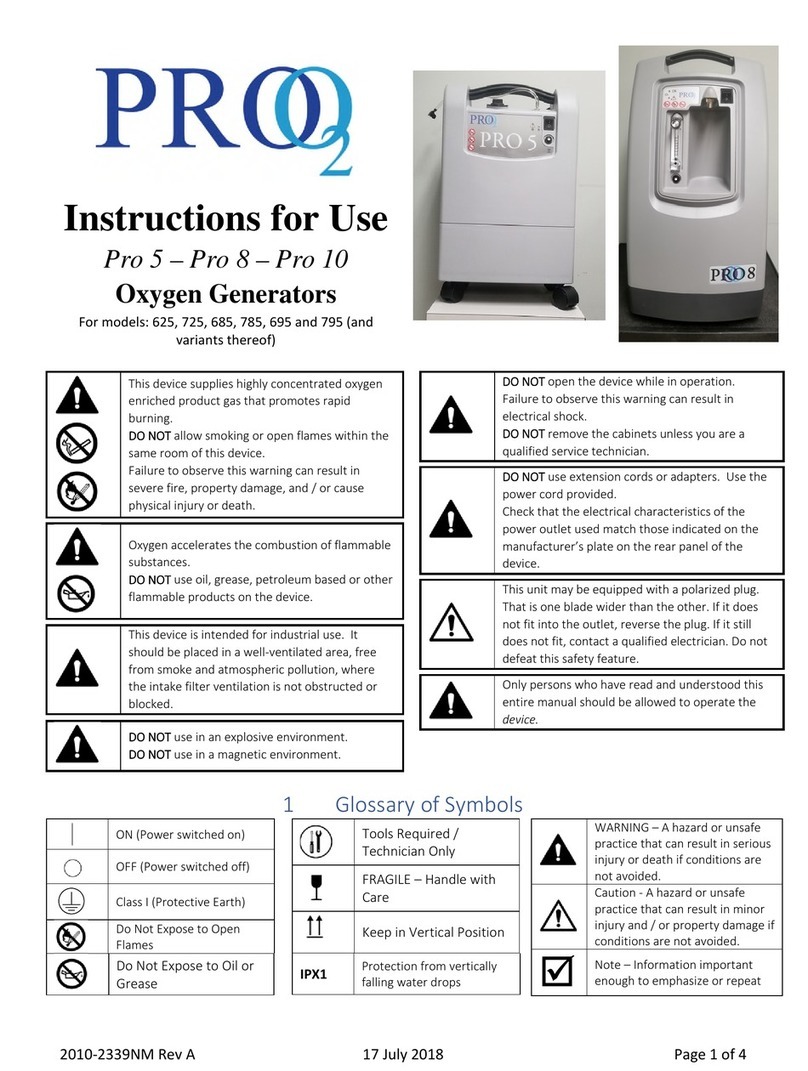
Pro2
Pro2 625 Instructions for use
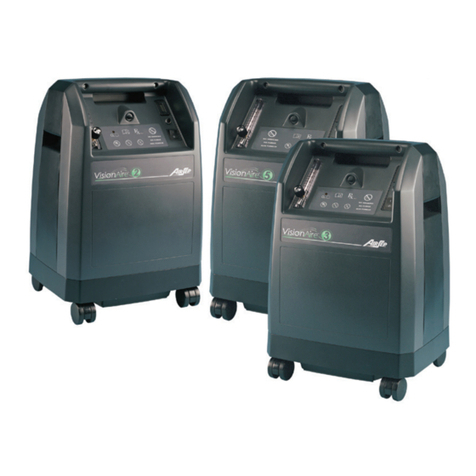
C-Aire
C-Aire AirSep VisionAire 5 Quick reference guide
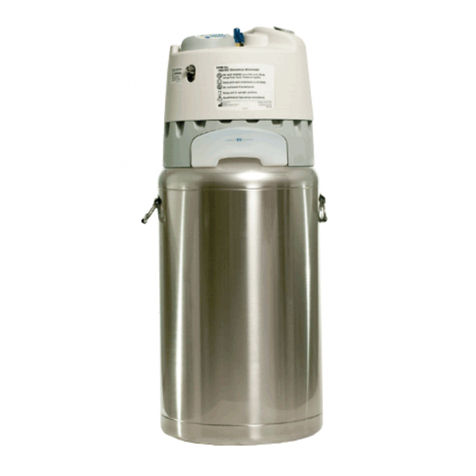
C-Aire
C-Aire HELiOS U36 user manual
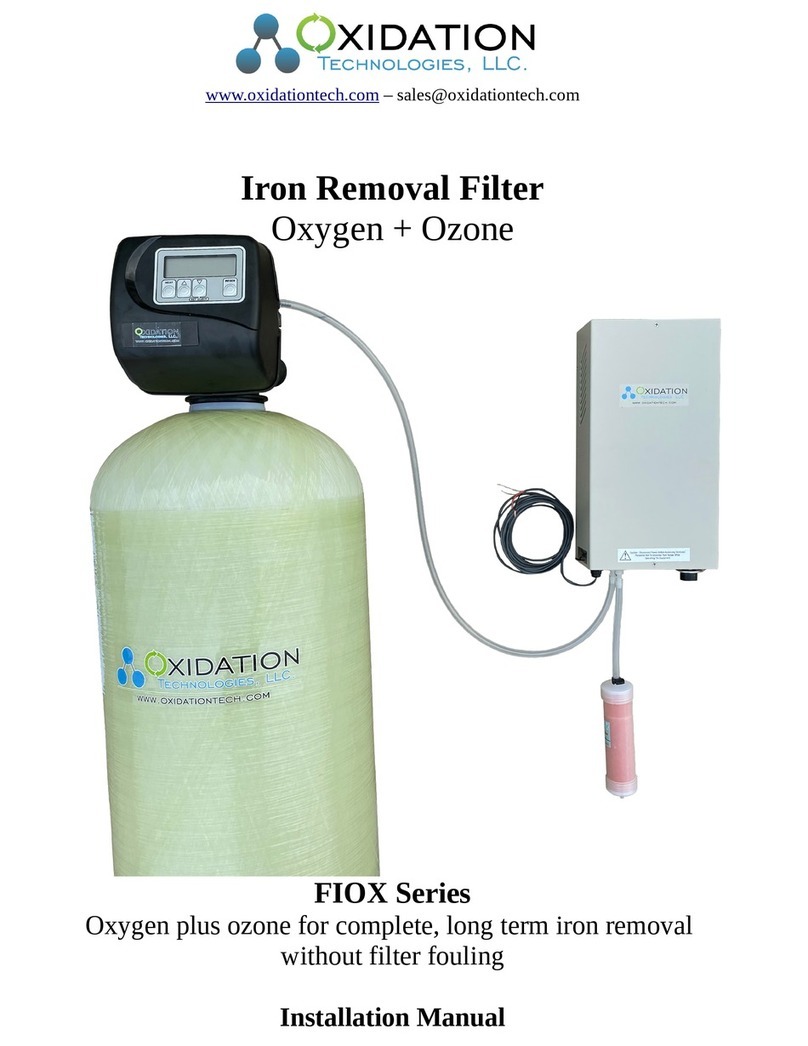
Oxidation Technologies
Oxidation Technologies FIOX Series installation manual

Suburban
Suburban OXYGEN THERAPY DOOR 12155-00-DRDRAA owner's manual
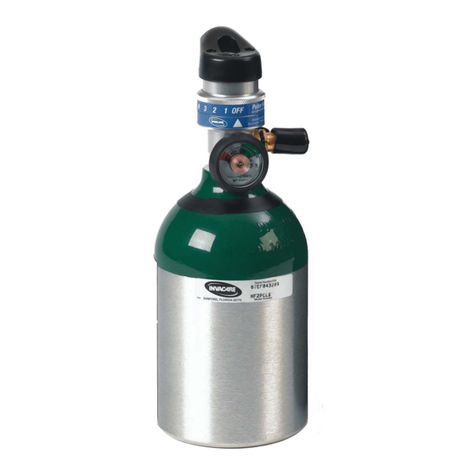
Invacare
Invacare HomeFill HF2PCL6 Operator's manual
